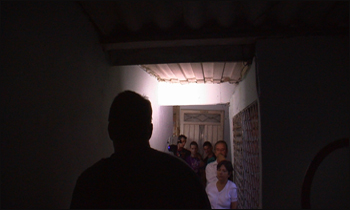Colombians Come to Fore in Alzheimer’s Research, Mass Media
Quick Links
If you follow Alzheimer’s disease research at all, chances are you have heard of the families in the South American nation of Colombia who comprise the largest known population stricken with early onset autosomal-dominant Alzheimer’s disease (ADAD). Passing relentlessly through the generations in a lineage of some 5,000 people, a single-nucleotide flaw in the presenilin-1 gene called the Paisa mutation is stalking some 25 extended families in the hilly Antioquia region of the northwest of the country. But you may not have fully caught on to how these families—after 30 years of giving time and tissue to research—have finally captured the sustained interest of researchers and drug companies around the world in a serious and broad-based way. That interest results from a combination of partnerships, new research, and media attention. It has created a new sense of hope among the families, which scientists and the pharmaceutical industry are now challenged to fulfill.

Town of Yarumal, Colombia. Image credit: Felipe Barral/CNN

Yarumal, Colombia. Image credit: Felipe Barral/CNN

Medellin, Colombia. Image credit: Felipe Barral/CNN
The families’ recognition among drug developers is growing in part because widespread frustration with clinical trial failures converges with the realization that this population might just help the whole field turn things around. But that is not the only reason. Francisco Lopera at Universidad de Antioquia, Medellin, has for most of his career been the families’ physician-researcher, the chronicler of their disease, and their beacon of hope. In 2009, Lopera teamed up with U.S.-based scientists in a collaborative drive toward prevention trials that is gaining momentum within the U.S. and European academic, drug development, and even regulatory AD community.
In Medellin itself, Lopera has built a group, called Grupo De Neurociencias De Antioquia, of some 50 neurologists, neuropsychologists, nurses, basic neuroscientists, junior researchers, and students. In the past year alone, they have prepared for anticipated prevention trials by screening 800 people for participation. That is an unprecedented number for any kind of human research in ADAD. Moreover, the researchers published four papers in the past six months, most recently on February 3 in Lancet Neurology (Acosta-Baena et al., 2011). Three of these papers are characterizing the preclinical phase of familial AD at earlier stages and in greater depth than was previously possible, by way of both paper-and-pencil tests and biomarker studies. The goal of this research is nothing less than a comprehensive description of memory, brain imaging, and fluid biomarker changes going back to the point in life when a mutation carrier first diverges on each of these measures from their non-carrying siblings. If necessary, and as appropriate, the researchers will trace those markers back to childhood, Lopera said. (For a summary of these new data, see Part 3 of this series.)
The last, and in some ways perhaps most powerful, ingredient to the family’s changing situation has been a flurry of media attention as their plight and their dignity have captured the imagination of both print and television journalists in Colombia, the U.S., and around the globe. In June of 2010, a New York Times story by Pam Belluck, a reporter who accompanied the Alzheimer’s Prevention Initiative (API) researchers on a visit to Antioquia, ran a haunting online video for streaming in four parts. Scientific American covered the API as well. On 29 January 2011, a feature-length documentary film by Felipe Barral, an artist and producer for CNN International, started airing on that channel and on CNN en Español (see ARF news flash and CNN website), with repeat shows all through February (see ARF related news brief). To the community’s disappointment, CNN domestic never aired the documentary, but it did upload it for screening in four parts on CNN.com (play Part 1, Part 2, Part 3, Part 4). On 17 February 2011, Sanjay Gupta talked about the API on Katie Couric’s “CBS Evening News.” Missed it? Catch the segment here. Last December, Colombia’s national newsmagazine Semana profiled Lopera in a year-end issue on important national leaders (see online version). Other Colombian newspapers ran stories as well (see El Espectador.com).

Colombian family with CNN cameraman. Image credit: Felipe Barral/CNN

Felipe Barral

CNN cameraman Greg Kilday films Kate Preskenis. Image credit: Felipe Barral/CNN
On the science front, things are moving as well. On 7 January 2011, some 80 scientists from the U.S. and European medicines regulatory agencies, the biopharma industry, academia, nonprofit foundations, and the government met in Washington D.C. for the latest round of planning called by the Alzheimer’s Prevention Initiative (Reiman et al., 2010). This was the third such gathering, each larger than the previous one. The API is widening the circle of participants in an inclusive and intensely collaborative joint effort to start what Eric Reiman calls an “era of prevention research.” Reiman, Pierre Tariot, and Jessica Langbaum of the Banner Alzheimer’s Institute in Phoenix, Arizona, lead the API with Lopera and colleagues in Phoenix and Medellin. The first API meeting, in October 2009, gathered mostly academic advisors. The second meeting, in January 2010, branched out to include industry representatives. Both groups roundly endorsed the initiative. For a detailed introduction to the API, see ARF related series.
At this most recent meeting in D.C., the group met for an update on how far the API has come in the past year (see Part 2 and Part 3), and for in-depth discussion with regulators of how best to design trials in this unique population (see Part 4 and Part 5). The day left the ball in the court of the pharma industry. Its representatives got answers to some of the questions they had asked in January 2010, and they heard a resounding plea to find ways of working collaboratively towards shared, creative trials of their most promising compounds (see Part 6).—Gabrielle Strobel.
This is Part 1 of a six-part series. See also Part 2, Part 3, Part 4, Part 5, Part 6 View a PDF of the entire series.
References
News Citations
- Detecting Familial AD Ever Earlier: Subtle Memory Signs 15 Years Before
- Phoenix: Vision of Shared Prevention Trials Lures Pharma to Table
- A Neurologist’s Devotion Puts Familial AD Research Onto New Plane
- Scientists and Regulators Discuss Preclinical AD Trials
- Can Adaptive Trials Ride to the Rescue?
- Time to Open the Kimono—Which Drugs in Preclinical Trials?
Paper Citations
- Acosta-Baena N, Sepulveda-Falla D, Lopera-Gómez CM, Jaramillo-Elorza MC, Moreno S, Aguirre-Acevedo DC, Saldarriaga A, Lopera F. Pre-dementia clinical stages in presenilin 1 E280A familial early-onset Alzheimer's disease: a retrospective cohort study. Lancet Neurol. 2011 Mar;10(3):213-20. PubMed.
- Reiman EM, Langbaum JB, Tariot PN. Alzheimer's prevention initiative: a proposal to evaluate presymptomatic treatments as quickly as possible. Biomark Med. 2010 Feb;4(1):3-14. PubMed.
Other Citations
External Citations
Further Reading
Annotate
To make an annotation you must Login or Register.

Comments
�
I am Colombian, and have family near the town of Yarumal. I think even if the treatment fails, many new things will be discovered, so it is worthwhile.
I think Alzheimer’s due to old age is different from the early onset autosomal-dominant Alzheimer’s disease in Yarumal. There is the possibility that the treatment works, at least partially, but that it won’t necessarily be effective for old age Alzheimer’s, considering that a lot is still unknown about the process of the illness. Still, partial success would be a lot for the people with ADAD.
Make a Comment
To make a comment you must login or register.